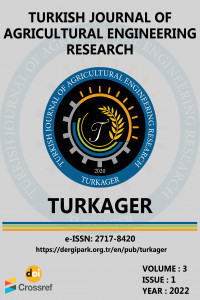Precipitation Intensity-Duration Occurrence Models Development for Designated Locations in the Southern Humid Rain Forest Zones of Nigeria
Precipitation Intensity-Duration Occurrence Models Development for Designated Locations in the Southern Humid Rain Forest Zones of Nigeria
This research work examined the tendencies and patterns in the rainfall in carefully chosen localities of Southwest and South-South Nigeria. Rainfall data from 1983-2014 in Ibadan, Lagos, Benin, Calabar, Port Harcourt and Warri were used for this study. Standard deviation, mean, coefficient of skewness, coefficient of kurtosis, coefficient of variation and standardized anomaly index were engaged to analyze the data and describe the distribution of rainfall in these stations. The data were analyzed using statistical package for social sciences, SPSS 17 and Minitab 16. The outcomes revealed that the maximum annual rainfall occurred at Warri station 4489.80 mm in the year 2008 and the minimum occurred at Benin 229.10 mm in 2005. Also, Benin has the maximum coefficient of variation of about 24.72%, while Port Harcourt has the minimum coefficient of variation of about 12.71%. Warri station was positively skewed indicating that it experienced frequent low rainfall values, while Port Harcourt was approximately symmetrical skewed. Warri has kurtosis coefficient of 4.45 which is highest among others. However, the patterns of rainfall in these areas are random or fluctuating. It is recommended that models built on the perceived decreasing rainfall, such as drainages, dams, have to be reviewed.
Keywords:
Anaysis, Climate Rainfall, Linear trends model, Variability,
___
- Akpan SU and Okoro BC (2013). Developing rainfall intensity-duration-frequency models for Calabar City, South-South Nigeria. American Journal of Engineering (AJER), 2(6): 19-24.
- Akpen GD, Aho MI and Ojo OG (2016). Rainfall Intensity-Duration-Frequency models for Makurdi metropolis, Nigeria. International Journal of scientific and Engineering Research, 7(5): 835-849.
- Elsebaie IH (2012). Developing rainfall intensity frequency relationship for two regions in Saudi Arabia. Journal of King Saudi University- Engineering Sciences, 24: 131-140.
- National Food Reserve Agency (NFRA) (2008). Investment opportunities in Nigeria agricultural sector. A bulletin of Federal Ministry of Agriculture and Water Resources, FCDA Compound, Area 11 Garki Abuja, Nigeria.
- Nwaogazie IL and Duru (2002). Developing rainfall- intensity-duration-frequency models for Port Harcourt City. Nigeria Society of Engineers Technical Transaction, 37(2): 19-32.
- Nwaogazie IL, Masi GS, Ricardo ZE and Edward G (2019). Probability and non-probability rainfall intensity-duration-frequency modeling for Port Harcourt metropolis, Nigeria, International Journal of Hydrology, 3(1): 66-75.
- Okonkwo GI and Mbajiorgu CC (2010). Rainfall intensity – duration – frequency analyses for southeastern Nigeria. Agricultural Engineering International: CIGR Journal, 12(1): 22-30.
- Ologhadien I and Nwaogazie Ify L (2014). Rainfall intensity – duration – frequency models for selected cities in Southern Nigeria. Standard Scientific Research and Essays, 2(10): 509-515.
- Onwualu AP, Akubuo CO and Ahaneku IE (2006). Fundamentals of engineering for agriculture. Published by Immaculate Publications Ltd. No. 2 Aku Street, Ogui New Layout, Enugu, Nigeria.
- Oyebande L (1982). Deriving rainfall intensity- duration-frequency relationships and estimates for regions with inadequate data. Hydrological Sciences Journal, 27: 353-367.
- Raiford JP, Aziz NM, Khan AA and Powel DN (2007). Rainfall depth- duration- frequency relationships for South Carolina, and Georgia. America Journal of Environmental Sciences, 3(2): 78-84.
- Yayın Aralığı: Yılda 2 Sayı
- Başlangıç: 2020
- Yayıncı: Ebubekir ALTUNTAŞ
Sayıdaki Diğer Makaleler
Application of Value Engineering to Identify and Solve Irrigation Water Allocation Problems
Nura Jafar SHANONO, Nuraddeen Mukhtar NASİDİ
David ONWE, Adeleke Isaac BAMGBOYE
Comparative Study of the Developed Peanut Shelling Machines
Olufemi ADETOLA, Opeyemi AKİNNİYİ, Emmanuel OLUKUNLE
Design and Performance Evaluation of Canola-Seed Cleaning Machine
Mohamed GHONİMY, Mohamed ROSTOM
Review on Solar Drying in Nigeria
Hilary UGURU, Ovie AKPOKODJE, Goodnews Goodman AGBI
Quality Evaluation of Foam Dried Watermelon Flakes
John ISA, Ayoola OLALUSİ, Omoba OLUFUNMİLAYO
Cordelia Chika EMEKA-CHRİS, Christopher OBİNECHE, Bejoy Otuobi UNANKA
Develi Ovası Topraklarının Yarayışlı ve Toplam Fosfor İçeriklerinin Belirlenmesi
